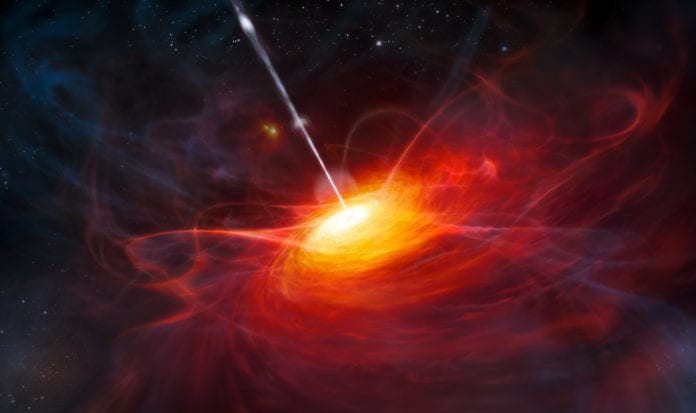
Quasars are truly terrifying objects. These are black holes at the center of extremely luminous and particularly active galaxies. At the center is generally a supermassive black hole with a mass that can range from millions to billions of times the mass of the sun. A gaseous accretion disk surrounds these black holes. Quasars often blow winds that can carry up to 100 times the energy of all the stars in the milky way galaxy. These outward pushes are so strong that they carry a lot of material away from their home galaxies. Some are so strong that they may even shut down star formation in their home galaxies.
Researchers at Virginia Tech in Blacksburg recently spotted three of the “largest, most energetic” outflow of material that has ever been observed. The outflow is so huge that the researchers suspect that it might be a big influence on the evolution of the galaxy.

An artist’s depiction of a quasar
The team used the Hubble Space Telescope to monitor the different properties of the winds from 10 different quasars. The researchers cannot directly see the outflows from the quasars. Therefore, to measure the different characteristics, they measure the wavelength of the light that filters through the gasses. This helps them as the gasses only absorb a certain wavelength of light given certain properties. Armed with this information, researchers can accurately tell the mass, speed, and energy of these gas outflows.
Quasars have been an object of fantasy for science-fiction for a long time now. Many depictions show the jets of material being ejected from the top and bottom of the black hole perpendicularly to each other. This might not be true. The most probable scenario speaks of the gasses being ejected in all the directions outwards from the black hole and expanding like a balloon.
This discovery is quite significant for multiple reasons. First, we have known for quite a long time that given enough energy, such outbursts could bring galaxy evolution to a halt. The only problem was that no outflows of such energy had yet been observed. With this discovery, we know that this phenomenon happens, and it needs to be taken into account.

Second, all the supercomputer simulations for the modern-day universe show and predict the presence of big galaxies in it. However, there are a lot less than what these models predict. Until now, we had no way of explaining the lack of these big galaxies, but with this discovery, we might just be able to set the record straight.
The light recorded from the outflows majorly lies in the ultraviolet region. There seem to be, on average, three outflows surrounding the quasars being monitored. The outflows are very well spread out from the galaxy, which means it is physically possible for them to interfere with the galaxy’s evolution. Another point of interest in this discovery is that researchers seemed to have discovered the largest acceleration ever. One of the outflows from the quasars seemed to have gained a velocity of 1,550 kilometres per second in just a matter of six years. This discovery has surely proved to be helpful in understanding the way our universe works.
Further Reading:

